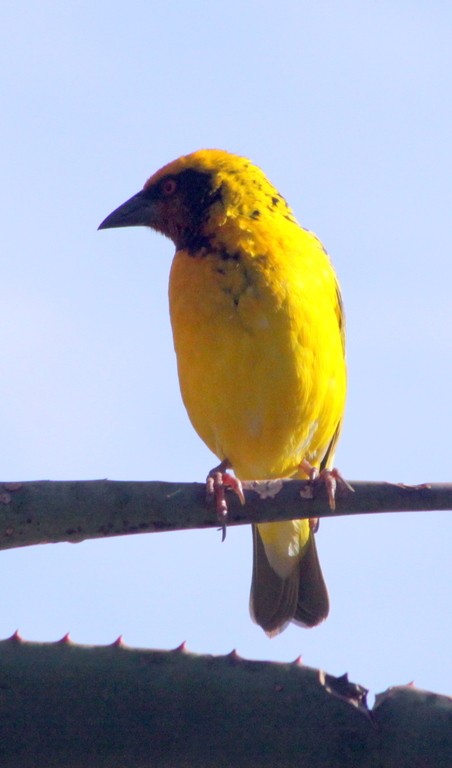Village Weaver
A species of Typical weavers Scientific name : Ploceus cucullatus Genus : Typical weavers
Village Weaver, A species of Typical weavers
Botanical name: Ploceus cucullatus
Genus: Typical weavers
Content
Description General Info
Description
The village weaver is a stocky 15–17 cm bird with a strong conical bill and dark reddish eyes. In the northern part of its range, the breeding male has a black head edged by chestnut (typically most distinct on the nape and chest). Towards the southern part of its range, the amount of black and chestnut diminish, and the breeding males of the southernmost subspecies only have a black face and throat, while the nape and crown are yellow. In all subspecies the breeding male has a black bill, black and yellow upperparts and wings, and yellow underparts. The non-breeding male has a yellow head with an olive crown, grey upperparts and whitish underparts. The wings remain yellow and black. The adult female has streaked olive upperparts, yellow and black wings, and pale yellow underparts. Young birds are like the female but browner on the back. 
Size
17 cm
Colors
Brown
Black
Yellow
Gray
White
Life Expectancy
24 years
Nest Placement
Tree
Feeding Habits
Village Weaver predominantly consumes seeds and grain, occasionally becoming a pest to crops. However, its diet also includes insects, particularly when provisioning for chicks, which mitigates some agricultural impact.
Habitat
Village Weaver's habitat spans Sub-Saharan Africa's bushy savannas, riverine woodlands, and wetlands. Adaptable to human-altered environments, it is also prevalent in cultivated areas, rural villages, and even urban gardens. Favoring open or semi-open landscapes with moderate vegetation, village Weaver avoids dense forests and arid zones, residing up to 2500 meters in elevation in some areas.
Dite type
Granivorous
General Info
Feeding Habits
Bird food type
Behavior
Village weavers forage and roost in large groups, often with other weaver species. In some areas, they move periodically along fixed routes. The birds look for food on the ground, but also look up to search vegetation and trees. The village weaver nests in colonies and is very active during the breeding season. Birds fly in and leave again constantly, making a lot of noise. Colonies can contain as many as 150 nests, but anything between eight and a hundred nests in a single tree is usual. A village weaver's nest is 14–17 cm (5.5–6.7 in) long and 11–13 cm (4.3–5.1 in) high. The entrance is mostly extended into a tube of 4–8 cm (1.6–3.1 in) long. The male weaves the structure of the nest using long strips of leaf, that he has torn from palms or large grass species such as Arundo donax. The nest is roofed, ovoid or kidney-shaped, internally consisting of a nesting chamber that is separated by a ground sill from an antechamber, that has the entrance of the entire nest at the bottom. On the inside, the ceiling is made of strips of grass or other leaves, which are simply inserted instead of woven-in. The floor on the inside is lined by short, thatched strips of palm, grass blades or heads, and feathers. The nest requires about three hundred long strips of leaf, which the male tears off and transports one by one. The male gathers building material throughout the building process, during which he works with his feet in exactly the same position, and maintaining the same orientation. He starts by creating the attachment by weaving around mostly two hanging branches just below a fork, a foot on both of them, which he includes in a ring he constructs by weaving in the plain of the branches at the edge of his reach. He than extends the high end of the ring in front of its head, gradually working towards his feet creating a half-globe, that is the nesting chamber. The male continues by constructing the roof of the antechamber, working over his head. This is followed by lining the ceiling, and constructing the entrance tube, hanging upside-down, but still with his feet at the same spots. The weaving technique consists of seizing a strip of near the end and double the strip back on itself. Next he pokes the end with a vibrating movement in between his previous work until it sticks. He then release it, moves his head to the other side of the nest wall, seizes the strip again and pokes it in somewhere. He keeps repeating this, regularly reversing the direction in which he weaves the strip, poking and pulling the strip through holes until the entire length is used. The female collects material too, but she occupies herself only with the lining of the nesting cup. 
Distribution Area
The village weaver is among the more common weaver bird species, and is widespread in Sub-Saharan Africa, but is absent from the arid regions in the South-West and North-East. 
Species Status
Not globally threatened.
Scientific Classification
Phylum
Chordates Class
Birds Order
Perching birds Family
Weavers Genus
Typical weavers Species
Village Weaver 